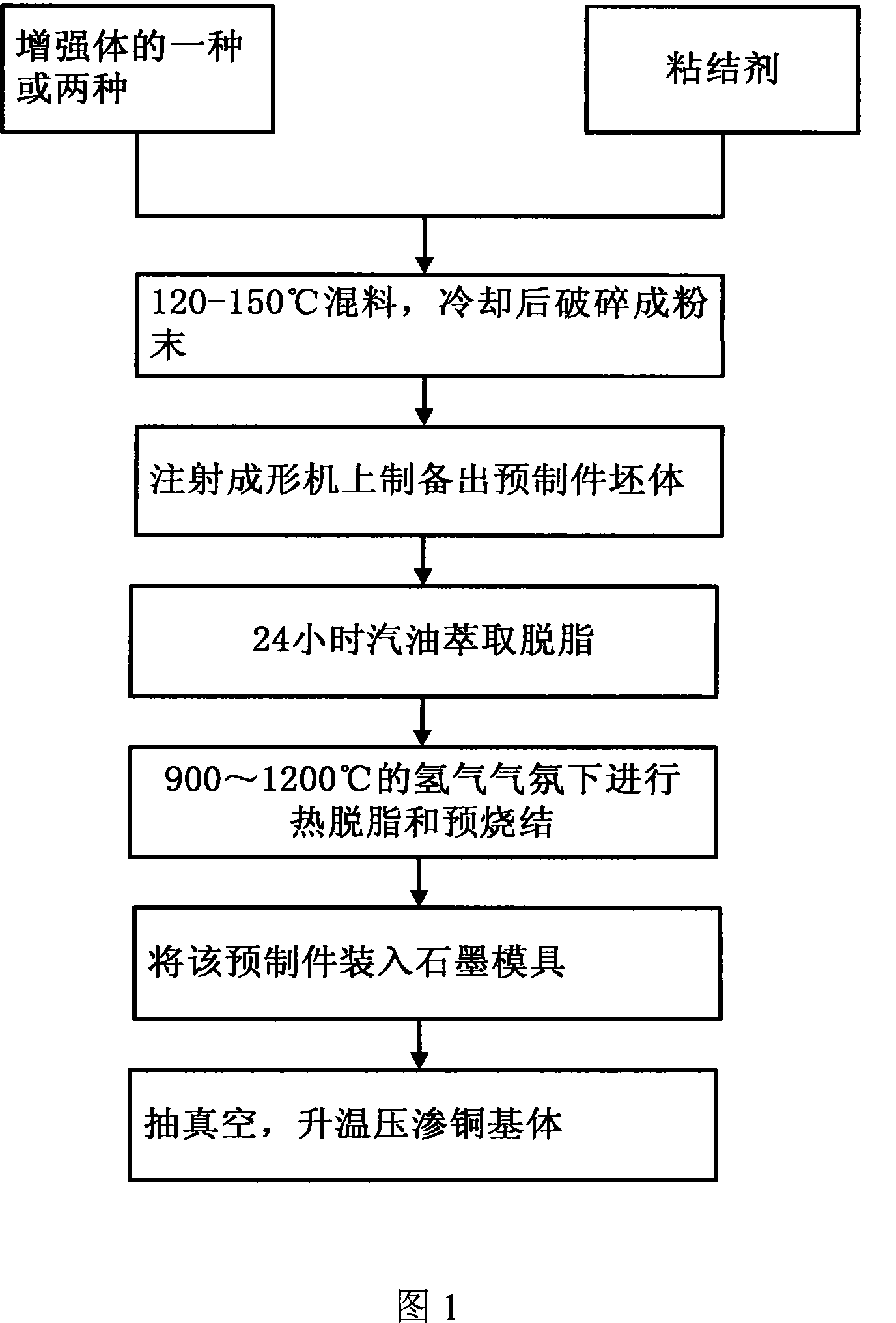High heat conductivity copper-base composite material and preparation method thereof
A copper-based composite material, high thermal conductivity technology, applied in the field of electronic packaging materials, can solve the problems of difficult preparation, complex structure, difficult processing, etc., and achieve the effects of reducing thermal stress, excellent performance, and overcoming poor wettability
- Summary
- Abstract
- Description
- Claims
- Application Information
AI Technical Summary
Problems solved by technology
Method used
Image
Examples
Embodiment 1
[0026] Raw materials: SiC particles with a particle size of 14 μm, electrolytic copper.
[0027] Mix 14 μm SiC particles and binder in a volume ratio (50:50) on a mixer at 130° C. for 1 hour, break into powder after cooling, and then prepare a preform body on an injection molding machine. Soak the preform body in gasoline for 24 hours to extract and degrease the binder. After natural air drying, perform thermal degreasing and pre-sintering at 1200°C for 1 hour in a hydrogen atmosphere to obtain a preform, which is then packed into graphite The electrolytic copper block is placed on the preform according to the volume ratio (50:50), and then placed in a pressure infiltration furnace. When the vacuum is pumped to 0.1Pa, the copper block metal is melted at a temperature of 1200°C. Pressure infiltration, furnace cooling, demoulding. The density of the obtained composite material is 6.24g / cm 3 , the thermal conductivity is 300W / m-K, and the thermal expansion coefficient is 10.9×1...
Embodiment 2
[0029] Raw materials: SiC particles with a particle size of 28 μm, oxygen-free copper.
[0030] Mix 28 μm SiC particles and binder in a volume ratio (75:25) on a mixer at 130° C. for 1 hour, break into powder after cooling, and then prepare a preform body on an injection molding machine. Soak the preform body in gasoline for 24 hours to extract and degrease the binder. After natural air drying, perform thermal degreasing and pre-sintering in a hydrogen atmosphere to obtain a preform, and then put it into a graphite mold, and Put the electrolytic copper block on the preform according to the volume ratio (75:25), and then put it into the pressure infiltration furnace. When the vacuum is pumped to 0.1Pa, the copper block metal is melted when the temperature rises to 1200°C, and the infiltration is carried out. Cold, unmold. The density of the obtained composite material is 4.88g / cm 3 , the thermal conductivity is 250W / m-K, and the thermal expansion coefficient is 8.2×10 -6 / K....
Embodiment 3
[0032] Raw materials: Copper-plated diamond particles with a particle size of 28 μm, electrolytic copper.
[0033] The copper-plated diamond particles of 28 μm and the binder were mixed on a mixer at 130 °C for 1 hour in a volume ratio (75:25), and then crushed into powder after cooling, and then prepared a preform body on an injection molding machine . Soak the preform body in gasoline for 24 hours to extract and degrease the binder. After natural air drying, perform thermal degreasing and pre-sintering in a hydrogen atmosphere to obtain a preform, and then put it into a graphite mold, and Put the electrolytic copper block on the preform according to the volume ratio (75:25), and then put it into the pressure infiltration furnace. When the vacuum is pumped to 0.1Pa, the copper block metal is melted when the temperature rises to 1100°C, and the infiltration is carried out. Cold, unmold. The density of the obtained composite material is 4.84g / cm 3 , the thermal conductivity ...
PUM
| Property | Measurement | Unit |
|---|---|---|
| size | aaaaa | aaaaa |
| particle diameter | aaaaa | aaaaa |
| density | aaaaa | aaaaa |
Abstract
Description
Claims
Application Information
 Login to View More
Login to View More - R&D
- Intellectual Property
- Life Sciences
- Materials
- Tech Scout
- Unparalleled Data Quality
- Higher Quality Content
- 60% Fewer Hallucinations
Browse by: Latest US Patents, China's latest patents, Technical Efficacy Thesaurus, Application Domain, Technology Topic, Popular Technical Reports.
© 2025 PatSnap. All rights reserved.Legal|Privacy policy|Modern Slavery Act Transparency Statement|Sitemap|About US| Contact US: help@patsnap.com

